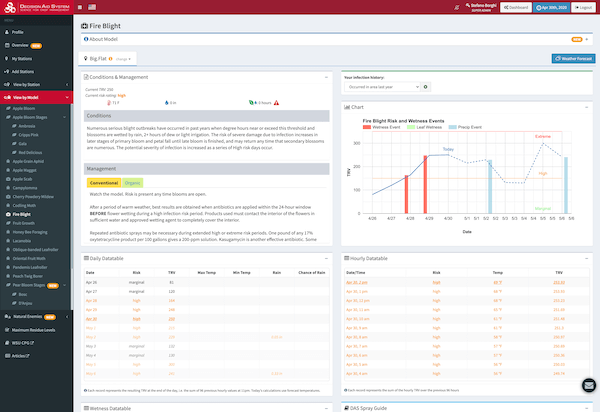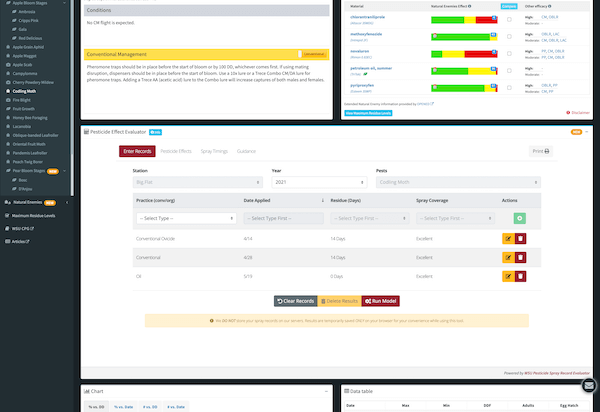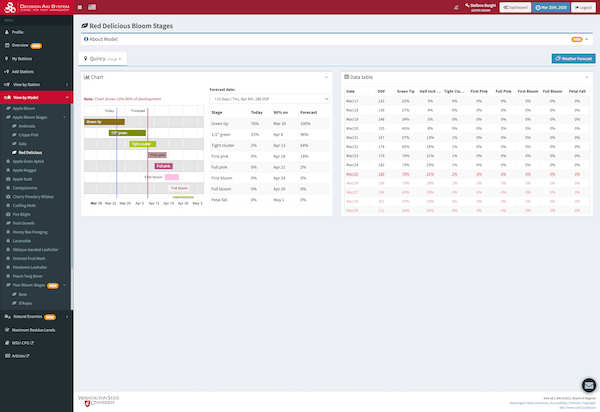About WSU-Decision Aid System
A collaborative project between WSU Extension and WSU Agricultural Research Center.
WSU-DAS is a web-based platform designed to transfer time-sensitive information to decision makers in the tree fruit industry. It runs insect, disease, disorder, and horticultural models to estimate the current status of the issue and links that to appropriate management and pesticide recommendations.
DAS is a comprehensive system that incorporates weather data from WSU-AgWeatherNet (AWN), forecasts provided by Weather Source, historic weather data from Daymet, and other information sources such as the WSU Orchard Pest Management Online and the WSU Crop Protection Guide . DAS attempts to support reasonably common smart phones and tablets (iOS and Android) as well as desktop computers in all functions. As designed, DAS also has a data/account management subsystem that simplifies use for decision makers and allows them to tailor the information they receive.
Mission Statement
The WSU-Tree Fruit Decision Aid System (DAS) is the premier source of time-sensitive information for management in Washington State tree fruits. We are open and eager to collaborate with scientists to integrate tools, management information, and models into DAS that will assist Washington tree fruit growers make the best management decisions and remain competitive in the world economy.
Strategic Vision
The development of DAS is guided by four goals and principles:
- Implement science-based tools that help with management of time-sensitive problems in entomology, plant pathology, horticulture, soil science and other allied sciences.
- Use technology to simplify and expand our ability to provide information in a broad range of areas to decision-makers in the tree fruit industry.
- Work with scientists to implement web and smartphone-based solutions to key technical problems faced by the tree fruit industry.
- Collaborate with other WSU-DSS and researchers in the region to implement science-based tools for the transfer of time-sensitive information to decision-makers. This includes sharing tools already developed by WSU-Tree Fruit DAS or implementing tools developed by other groups.
How It Works
Who is it for?
- for pest management decision makers in the tree fruit industry
What does it provide?
- time-sensitive information on pest development, management options, and pesticide recommendations
- accessibility on common smartphones and tablets (iOS and Android)
How does it work?
- sign up for an account (user fees required per weather station annually, all models included)
- choose weather stations near your orchard location
-
choose pest and horticultural models
- Insect models: apple maggot, Campylomma bug, codling moth, honeybee foraging, Lacanobia fruitworm, oblique-banded leafroller, oriental fruit moth, Pandemis leafroller, peach twig borer, San Jose scale, Western cherry fruit fly
- Diseases: apple scab, fire blight, cherry powdery mildew
- Horticultural models: blooming (Ambrosia, Cripps Pink, Gala, Red Delicious), fruit growth (Cripps Pink, Gala, Red Delicious), bloom timing (Fuji, Golden Delicious, Granny Smith, Jonagold)
- Disorders: storage scald, sunburn browning of apple
-
view model output
- current and forecasted status of pests or issue
- management recommendations depending on the pest status
- access management information from the WSU Crop Protection Guide
How DAS Was Developed
DAS was launched in 2007 with 12 models; it now includes 29 models with more in the pipeline. For the first 7 years, DAS was supported on competitively acquired grant funds from state, federal and industry funds (sources are shown in the pie chart - none of the WSU faculty time is listed).
Grants are provided by a particular agency to further the goals of that agency that also help WSU meet our land grant mission. These funds are a legal contract ensuring that WSU will meet the objectives outlined in the grants within a particular time frame (generally 1-3 years). However, these grants do not allow obligations once the granting period is over and funds are expended.
The granting agencies (including the Washington Tree Fruit Research Commission) made it very clear that they will not support projects that have any maintenance of DAS associated with them. Nor will they pay for the implementation of new features based on previous finished research. Therefore, alternative funding sources are needed to support the upkeep and expansion of this service.

User Fees
We have set the fees ($250.00/station) based on previous use patterns and with the goal of meeting the program's needs to both run the system and to keep improving the system. A flat fee was set for all users, so that everyone pays the same amount for the services they use. There may be some price adjustments in the future to make sure that the cost-sharing is as fair as possible while guaranteeing stable funding for the program.
Each individual making management recommendations using DAS is required to register for an account for the station(s) where management information from DAS is needed. This annual fee provides access to all models and all the synthesized data associated with the site(s).
A Tool Used By The Industry
We performed user surveys in 2008, 2010, and 2013 to estimate usage and areas where we needed to improve the system. The results showed that DAS is used by the majority of IPM decision makers in the industry in Washington State.
- Roughly 400 managers or management consultants use DAS on a regular basis on >90% of the acreage throughout the season.
- In all three surveys users estimated that the value for DAS to the industry was roughly $16.5M/yr.
- Users felt that DAS clarified treatment timing, improved their overall management program, helped them choose pesticides for best efficacy and least effects on natural enemies, and was a good source of general IPM information.
- Users also reported better pest control and lower management costs.
- DAS users indicated that 81% of them shared information on DAS with others, suggesting that its impact is broader than what can be estimated by just counting those who regularly access the web site.
Testimonies By DAS Users
- "Invaluable tool which I and other consultants use daily."
- "You have done wonders. It's by far the best DSS [Decision Support System] anywhere."
- "DAS will be great for new people coming into agriculture. It has been a help to those of us near going out. Our company has an internship program for young people entering agriculture. I encourage them to use this program. When you advise to farm, you need the weather every day. Thank you!"
- "It's a great system, keep up the good work, thanks!"
- "Thanks for the great tool."
Staff

Director of DAS
Associate Professor of Entomology
Washington State University

Outreach Coordinator
Washington State University

Information Systems Manager
Charlotte, NC

Software Developer & Researcher
Washington State University

Ecological Model Developer
Research Assistant Professor
Washington State University

Ecological Model Developer
Research Assistant Professor
Washington State University

Ecological Model Developer
Postdoctoral Associate
Washington State University

Ecological Model Developer
Postdoctoral Associate
Washington State University
Collaborators and previous staff

Professor of Entomology
WSU Tree Fruit Research & Extension Center

Information Systems Manager
WSU Tree Fruit Research & Extension Center

Data Scientist
Washington State University

Web Developer
WSU Tree Fruit Research & Extension Center

DAS Consultant
Staff Scientist, Entomologist
WSU Tree Fruit Research & Extension Center




